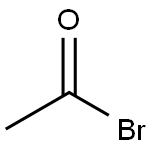Acetyl bromide , 97% , 506-96-7
Synonym(s):
Acetic acid bromide, Acetoxy bromide;Acetyl bromide
CAS NO.:506-96-7
Empirical Formula: C2H3BrO
Molecular Weight: 122.95
MDL number: MFCD00000114
EINECS: 208-061-7
PRODUCT Properties
| Melting point: | -96 °C |
| Boiling point: | 75-77 °C(lit.) |
| Density | 1.663 g/mL at 25 °C(lit.) |
| vapor density | 4.3 (vs air) |
| vapor pressure | 92.2 mm Hg ( 25 °C) |
| refractive index | n |
| Flash point: | >230 °F |
| storage temp. | Store at <= 20°C. |
| solubility | Miscible with ether, chloroform, benzene and acetone. |
| form | Fuming Liquid |
| color | Clear colorless to dark yellow |
| Odor | Acrid and sharp. |
| Water Solubility | REACTS |
| Sensitive | Moisture Sensitive |
| Merck | 14,82 |
| BRN | 1697546 |
| Dielectric constant | 16.5(Ambient) |
| InChIKey | FXXACINHVKSMDR-UHFFFAOYSA-N |
| CAS DataBase Reference | 506-96-7(CAS DataBase Reference) |
| NIST Chemistry Reference | Acetyl bromide(506-96-7) |
| EPA Substance Registry System | Acetyl bromide (506-96-7) |
Description and Uses
Acetyl bromide is a colourless fuming liquid with pungent odour, is combustible, and turns yellow on exposure to air. It is used as an acetylating agent in the synthesis of fine chemicals, agrochemicals, and pharmaceuticals. It is also used as an intermediate for dyes. Acetylation, a case of acylation, is an organic synthesis process whereby the acetyl group is incorporated into a molecule by substitution for protecting –OH groups.
Acetyl Bromide is used as an acetylating agent in the synthesis of fine chemicals, agrochemicals and pharmaceuticals. It is also used as an intermediate for dyes. Further, it reacts with alcohols and amines to produce acetate esters and acetamides. In addition to this, it is involved in the synthetic process of the anti-HIV agent.
Safety
| Symbol(GHS) |  GHS05 |
| Signal word | Danger |
| Hazard statements | H290-H314 |
| Precautionary statements | P234-P280-P301+P330+P331-P303+P361+P353-P304+P340+P310-P305+P351+P338 |
| Hazard Codes | C |
| Risk Statements | 14-34 |
| Safety Statements | 26-36/37/39-45-9-25 |
| RIDADR | UN 1716 8/PG 2 |
| WGK Germany | 3 |
| RTECS | AO5955000 |
| F | 9-21 |
| TSCA | Yes |
| HazardClass | 8 |
| PackingGroup | II |
| HS Code | 29159080 |
| Hazardous Substances Data | 506-96-7(Hazardous Substances Data) |




